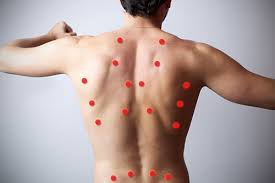Trigger Point Therapy – Trigger point therapy differs from other types of Western massage in that the receiver actively participates in the massage through deep breathing. It is based on the idea that a trigger point in one area of the body may cause pain in another area. By releasing tension in the muscles at the trigger point, you may be able to relieve pain in the corresponding area.
Trigger points are painful spots in the muscle tissue that radiate pain to other areas. A trigger point is an indication that the body has experienced some form of physiological dysfunction, such as poor posture, repetitive mechanical stress, a mechanical imbalance such as legs of different lengths, or acute trauma. A unique feature of trigger points is that they almost always refer pain to other areas of the body.
Trigger points are part of a protective mechanism of your body, an important defense reflex that keeps your body safe. Problems occur when the reflex misfires or doesn’t switch off – causing ongoing pain and stiffness.
Trigger point therapy is a technique in which trigger points are located and manipulated to reduce the pain and "deactivate" the point. This technique is sometimes also called myofascial trigger point therapy. (Myo means muscle tissue, and fascia is the connective tissue in and around it.)
What Can Trigger Point Therapy Do?
Trigger point therapy can reduce pain, increase movement, and allow the muscles to soften, lengthen, and become stronger. Moderate pressure should be used when treating triggers points. If the therapist presses too hard you will tense up against the pressure, and the muscle won't relax.
Trigger point therapy basically involves ischemic compression, a gentle and non-invasive way to deactivate trigger points, and stretching.
Trigger point release technique might be a bit uncomfortable but it shouldn't cause pain. In fact, muscles in pain tend to tense up, so causing pain will hinder the technique working correctly. If it hurts too much, you will start to tense your muscles in a protective response.
During trigger point therapy, the massage therapist locates the trigger point by pressing on the muscle tissue with a finger (palpation) or by picking up the muscle fibers in a pincer grip.
Once the trigger point is located, the therapist applies pressure until the pain gradually dissipates.
Applying Pressure to Help Reset The Muscle
The therapist asks you to rate the intensity of the discomfort on a scale of one to ten, with one being "no or very little discomfort" and ten "excruciating". The therapist applies pressure, gradually increasing until you reach a discomfort level of five or six. The therapist then holds the pressure steady until the discomfort eases off to about a level two. Then she applies more pressure, holding it again until the discomfort level goes down. When the discomfort level reaches a "two," the point is considered to be deactivated.
What You Should Know About Trigger Point Therapy
It is used to treat painful trigger points that cause referred pain.
It took a while to get the muscle in that condition, and it will likely take more than one massage to get rid of it.
These points are often areas of chronic "holding" and you need to learn how to move in different ways to keep them from recurring.
It can be uncomfortable but should give lasting relief.
Normal muscles do not contain taut bands of muscle fibers or trigger points.



